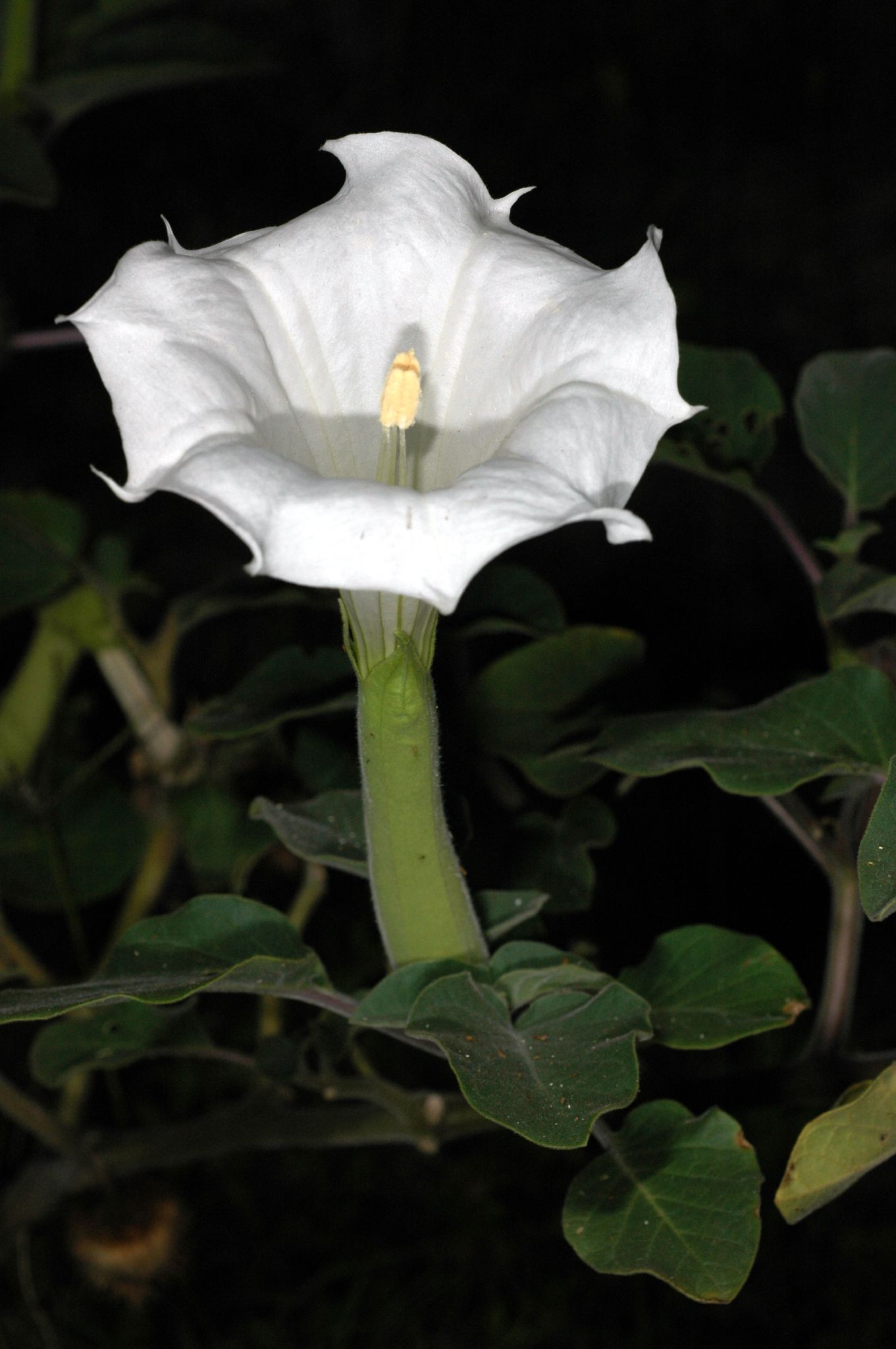Datura wrightii
| Sacred Datura | ||||||||||||||
|---|---|---|---|---|---|---|---|---|---|---|---|---|---|---|
 Sacred Datura blooms at night
| ||||||||||||||
| Scientific classification | ||||||||||||||
| ||||||||||||||
| Binomial name | ||||||||||||||
| Datura wrightii Regel |
Datura wrightii or Sacred Datura is the name of a poisonous perennial weed and ornamental flower of southwestern North America. It is sometimes used as a hallucinogen. Datura wrightii is classified as a deliriant and an anticholinergic.[1]
It is a vigorous herbaceous perennial[2] that grows 30 cm to 1.5 m tall and wide.[3] The leaves are broad and rounded at the base, tapering to a point, often with wavy margins. The flowers are the most striking feature, being sweetly fragrant white trumpets up to 20 cm (8 inches) long, often tinted purple, especially at the margin. There are five narrow points spaced symmetrically around the rim. It can bloom from April to October.[2] In clear weather, flowers open at nearly full dark and wither a few hours after sunrise the following morning; in cloudy weather, they may open earlier and last longer.
The seeds are borne in a spiny, globular capsule 3 to 4 cm in diameter, which opens when fully ripe.[2]
Datura wrightii is found in northern Mexico and the adjoining U. S. states, as far north as southern Utah, in open land with well-drained soils.[2] It is also commonly planted as an ornamental, especially in xeriscapes.
The name commemorates the botanist Charles Wright.
Other names
In the U.S. it is sometimes called (Western) Jimsonweed[3] because of its resemblance to Datura stramonium. Anglophone settlers in California often called it "Indian whiskey" because of its ritual intoxicating use by many tribes; the name "sacred datura" has the same origin. Other common names include "Indian apple"[2] and "nightshade". The Tongva call it manit and the Chumash momoy. Mexicans call this and similar species tolguacha[2] or toloache.[4]
The scientific name has frequently been given as Datura meteloides Dunal,[3] but this name is actually a synonym of D. inoxia Mill., a Mexican plant with a narrower flower having 10 rather than 5 "teeth" at the rim.[2]
Uses
Religious
Datura wrightii is a sacred plant that has been used in sacred ceremonies and rites of passage by Chumash, Tongva, and other tribes. Among the Chumash, when a boy was 8 years old, his mother gave him a preparation of momoy to drink. This was supposed to be a spiritual challenge to the boy to help him develop the spiritual wellbeing that is required to become a man. Not all of the boys survived.[1] Momoy is a spiritual plant that helps with spiritual wellbeing among adults also. For instance, during a frightening situation, such as when seeing a coyote walk like a man, a leaf of momoy is sucked to help keep the soul in the body. The plant was also used to tell the future, especially when gambling.
Recreational
Datura wrightii can also be used to induce a recreational hallucination. The plant can induce auditory and visual hallucinations similar to those of Datura stramonium. However, the hallucinations are sometimes fatal due to panic that overcomes the person. Scopolamine in the plant takes away a person's vision. As the person panics and attempts to run to safety, the person cannot see, frequently becomes involved in an accident and ends up in the hospital. Scopolamine induces respiratory depression at hallucinogenic doses. The combination of anesthesia (in the hospital) and Datura is usually fatal due to combined respiratory depression.[1] Seizures and fevers as high as 110 F. have been reported.
References
- ↑ 1.0 1.1 1.2 Cecilia Garcia, James D. Adams (2005). Healing with medicinal plants of the west - cultural and scientific basis for their use. Abedus Press. ISBN 0-9763091-0-6.
- ↑ 2.0 2.1 2.2 2.3 2.4 2.5 2.6 Arthur Cronquist, Arthur H. Holmgren, Noel H. Holmgren, James L. Reveal, Patricia K. Holmgren (1984). Intermountain Flora; Vascular Plants of the Intermountain West, U.S.A., vol. 4. Subclass Asteridae (except Asteraceae). The New York Botanical Garden. ISBN 0-231-04120-9.
- ↑ 3.0 3.1 3.2 Theodore F. Niehaus, Charles L. Ripper, and Virginia Savage (1984). A Field Guide to Southwestern and Texas Wildflowers. Houghton Mifflin Company. ISBN 0-395-36640-2.
- ↑ Toloache (Jimson Weed) from Devil's Punchbowl Natural Area, accessed 16 June, 2006
External links
| Wikimedia Commons has media related to Datura wrightii. |